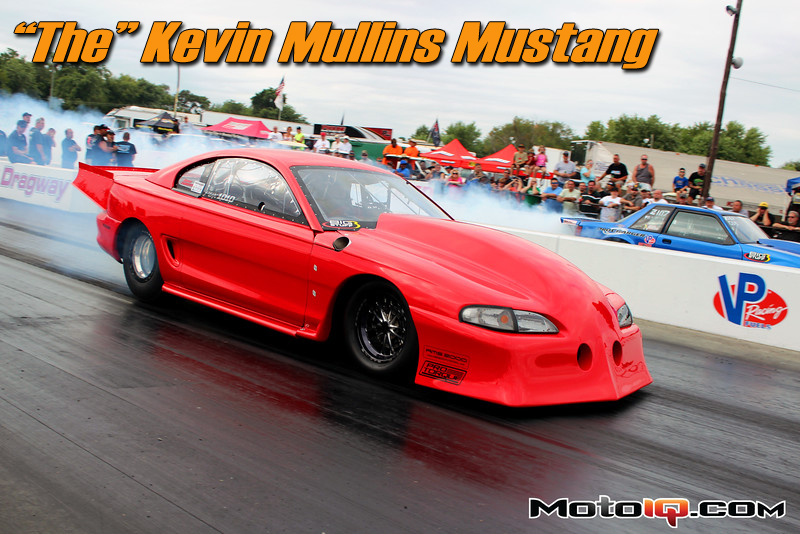
Kevin Mullins' Record Setting Mustang
An interesting guy once said that drag racing is “an exercise in keeping your eyes pointed forwards in your head”. While that might be the case for your run-of-the-mill street car, Kevin Mullins' 1997 Drag Radial Mustang requires an obscene level of coordination of myriad systems to propel it down the track at a world record pace.
This back-halved Mustang has to put all of its thousands of horsepower through two tiny tires – a class-limited 315mm wide Mickey Thompson DOT-approved drag radial. These “small tire” cars are extremely complicated animals.
While it certainly isn't easy to make thousands of horsepower like these cars do, the knowledge is out there and most competitors are all putting up similar numbers. What really tends to set these cars and teams apart is their attention to detail on suspension set up and tuning. While all drag cars are primarily concerned with traction and handling in one direction, the lack of forgiveness of a radial tire with its extremely stiff sidewall and (comparatively) small contact patch means that controlling traction throughout the run as the car travels down the strip makes all the difference. Mullins has clearly shown that he has what it takes to not only put the car together, but to get it down the track – quickly.
The vast majority of the engineering, design and tuning work goes into the back half of modern drag cars, and Mullins' ride is no exception. While it doesn't look like much, a lot of time and effort and attention to detail has gone into the rear end, and it shows in Mullins' timeslips.
Mullins logs a ton of data, and samples some data points up to 500 times per second. The parameters of the car are examined throughout the whole run to help determine how to change the car's set up to get it down the track faster. Shock and other suspension settings are modified to affect the launch, the shift, the ride height throughout the run, and more. Just tuning the launch involves changes to boost, RPM, torque converter solenoid pressures, front- and rear- damping settings, engine parameters and more. And they might be adjusted after every run! With enough data from each track, teams can start to build log books and data history that helps them to initially set up the car for an event as well as to more quickly dial it in on race day. The level of data analysis that goes on in the pits at a radial race rivals some high-end road racing events!
With lots of help from Loflin Fabrication and the other companies below, Mullins builds, tunes and goes through all of this effort to achieve one goal: quicker ETs and faster top speeds. A truly modern race car packed with technology, “The” Kevin Mullins Mustang deserves a much closer look.
 The Mustang has a little bit of a sacrilegious setup as far as fast Fords go: a 521 cubic inch Brad Anderson Enterprises Hemi. While small block Ford and Chevrolet engines may be ubiquitous street motors, in the fast-pased world of radial drag racing, parts availability is king. With “door cars” (drag chassis with still-functional opening/closing doors) all over the country running the big-block Hemis, it's easy to find all kinds of engine internals, even while at the track. That can mean the difference between depressing trailer haul home and a world record run.
The Mustang has a little bit of a sacrilegious setup as far as fast Fords go: a 521 cubic inch Brad Anderson Enterprises Hemi. While small block Ford and Chevrolet engines may be ubiquitous street motors, in the fast-pased world of radial drag racing, parts availability is king. With “door cars” (drag chassis with still-functional opening/closing doors) all over the country running the big-block Hemis, it's easy to find all kinds of engine internals, even while at the track. That can mean the difference between depressing trailer haul home and a world record run.The BAE 521cid Hemi is precariously perched in the Mustang. Ford never thought about putting such a wide motor under the hood, and a lot of meticulous fabrication was required to not only place the engine in the bay but also to make sure that the engine was as serviceable as possible at the track. A Racecraft Stilletto K-member was used which lets the team drop the oil pan without having to move the motor. Surprisingly, Mullins was able to retain the class-required factory strut towers – barely.
Another surprising thing in the engine bay is the lack of a radiator. As these motors typically run less than 60 seconds, the weight and complexity of a cooling system are simply skipped. While it may not be high-tech, it is extremely efficient.
 This alcohol-powered beast leverages a humongous MSD Pro Mag 44, a magnet- and point-free magneto capable of providing 44 amps of spark energy, to ignite the 50+ pounds of boost that is being force-fed into the motor.
This alcohol-powered beast leverages a humongous MSD Pro Mag 44, a magnet- and point-free magneto capable of providing 44 amps of spark energy, to ignite the 50+ pounds of boost that is being force-fed into the motor. Twin 94 millimeter Garrett turbochargers provide the boost. Mullins' car runs on alcohol and so it does not use an intercooler. This drastically simplifies the “hot pipe” plumbing out of the massive compressors – just up and into the intake. Turbosmart wastegates keep things under control and Turbosmart blow-off valves let things escape when the throttle plate stops the party.
Twin 94 millimeter Garrett turbochargers provide the boost. Mullins' car runs on alcohol and so it does not use an intercooler. This drastically simplifies the “hot pipe” plumbing out of the massive compressors – just up and into the intake. Turbosmart wastegates keep things under control and Turbosmart blow-off valves let things escape when the throttle plate stops the party.


